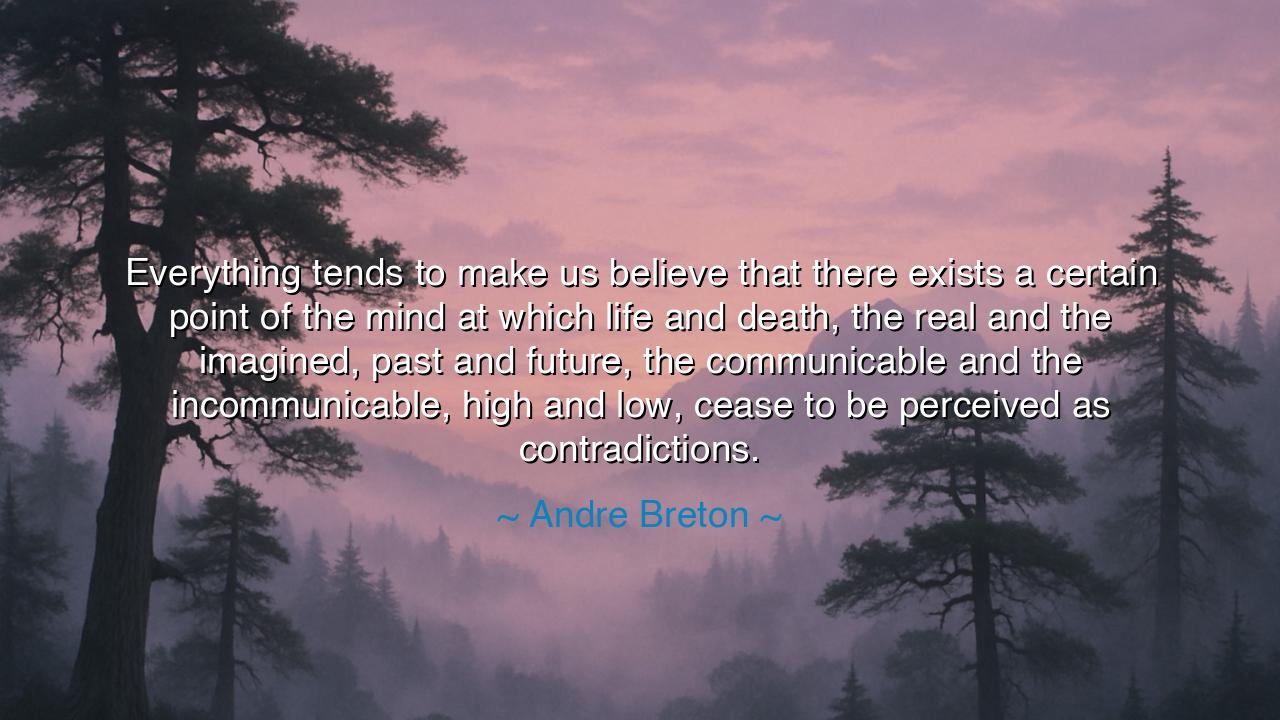
Everything tends to make us believe that there exists a certain
Everything tends to make us believe that there exists a certain point of the mind at which life and death, the real and the imagined, past and future, the communicable and the incommunicable, high and low, cease to be perceived as contradictions.






"Everything tends to make us believe that there exists a certain point of the mind at which life and death, the real and the imagined, past and future, the communicable and the incommunicable, high and low, cease to be perceived as contradictions." In these deeply reflective words, André Breton speaks to a profound realization about the nature of existence. This is not merely a question of philosophy or art, but a meditation on the very fabric of human experience. Breton suggests that there exists within the human consciousness a place, a moment, where the boundaries we perceive between life and death, reality and illusion, time and timelessness no longer hold sway. Here, contradictions dissolve, and we experience the world in its purest, most unified form.
The ancient Greeks grappled with such dualities—how can one truly understand life without understanding death? How can the real be distinguished from the imagined? These questions echoed through the works of Plato and Heraclitus, both of whom saw the world as a constant interplay of opposites. Heraclitus famously said, “Strife is justice,” recognizing that opposites are not only necessary but complementary to the natural order. In his worldview, life and death, good and evil, change and stability were not contradictions, but interconnected forces that together formed the full spectrum of existence. The lesson here is that the perception of contradiction arises from the limitations of the mind, and to transcend these limitations is to find harmony in the tension between opposites.
Breton’s words are also a reflection on the teachings of Buddhism, where the ultimate goal is to transcend the dualities of life and death, self and other, and even form and emptiness. The Buddha taught that suffering arises from attachment to the belief in fixed distinctions, yet true enlightenment comes when the mind sees beyond these divisions. In moments of deep meditation, the dualities of the world fade away, and the practitioner experiences a state of unity with all things, where the distinctions of self and other no longer hold. Breton’s quote aligns with this vision of spiritual transcendence, where one moves beyond the oppositions that define ordinary experience and into a state where all is one.
In modern history, thinkers like Carl Jung explored similar concepts when they delved into the unconscious mind. Jung believed that the unconscious contains both the light and darkness, and it is through integration of both that the individual can attain wholeness. He suggested that the opposites—good and evil, conscious and unconscious—are both necessary to understand the totality of the human experience. Jung’s work mirrored Breton’s, recognizing that life is not about avoiding contradiction but rather embracing it as part of a greater, unified experience. The mind can hold both life and death, both the real and the imagined, in a state of harmony when it is not bound by rigid distinctions.
A real-life example of this transcendence of dualities can be seen in the life of Leonardo da Vinci, whose genius lay not in separating art from science, but in integrating them. Leonardo’s study of human anatomy, his scientific sketches, and his paintings like the Mona Lisa all demonstrate a seamless connection between seemingly disparate realms—the logical and the artistic, the real and the imagined. He saw no contradiction in exploring both the physical world and the spiritual world. For him, the ability to perceive beyond boundaries was a key to understanding the true nature of reality. Leonardo’s work represents the unification of opposites, where the scientific and the artistic live in harmony, transcending the limitations of thought.
Breton’s quote, then, is not merely about dissolving contradictions but about recognizing that these perceived opposites are, in fact, part of a larger whole. The challenge is to see beyond the surface-level divisions and find the underlying unity that connects all things. To live with this awareness is to experience life with a deep sense of connectedness—where the past and future, high and low, life and death are not competing forces but complementary parts of the same cosmic dance. This is a life lived in profound awareness of the interconnectedness of all things.
The lesson we can draw from Breton’s words is that perception itself is the key. Our minds often create artificial boundaries between experiences, emotions, and ideas, but true wisdom comes when we see beyond these boundaries. To live fully is to embrace the paradoxes, to recognize that life and death, reality and illusion, joy and sorrow are not separate but woven together in a tapestry of existence. The practical action we can take is to begin to question the dualities we live by, to look deeper into our experiences and see where these opposites might merge into something greater. In our own lives, we can strive to embody the wisdom of the ancients, living in a way that transcends division, where all things are seen as interconnected, whole, and unified.
In our own journey, let us remember that the future is not merely a continuation of the past, and the apparent contradictions of life are not obstacles but gateways to deeper understanding. Life and death are not opposing forces but are part of the cycle of existence, just as the real and the imagined often blend to create the most profound truths. The true path is to transcend the limitations of dualistic thinking, to embrace the mystery and beauty of life in its full spectrum, and to see beyond the divisions that our minds often create. This is the wisdom of the ages—one that we must seek to understand and embody in our own lives.






AAdministratorAdministrator
Welcome, honored guests. Please leave a comment, we will respond soon